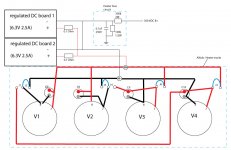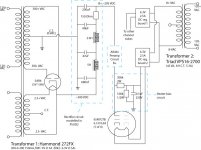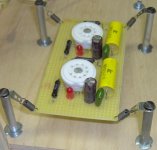Hi all,
I've been enjoying my Aikido line stage for about a year now. I'm using 4 6sn7s with a B+ of about 330 VDC.
The problem I am having is many of these tubes seem to become microphonic within a few months. I've tried the new Tung Sol and NOS Sylvania (Admiral, Philco.) So far I've gone through 4 that start to whine. I've placed my transformers on a 3/8" each of cork and rubber mat. This has helped slightly. I've also suspended the the PCB from the chassis using the same material as buffering pads.
The preamp is very sensitive, touching the tubes or tapping the chassis can be easily heard through the speakers.
At this point I am looking for alternative tubes. Given my relatively high plate voltage, octal pin scheme and 6.3V heaters, it seems that the options I have are the 6BL7 and 6BX7. I am willing to sacrifice gain, I rarely listen to my system past 10 o'clock but would rather not spend too much or totally sacrifice sound. (I presume the ECC33 is out.) The other octal twin triodes I've found have plate voltage limitations.
Any ideas? Bomb-proof tubes with low microphonics or another fix, perhaps restraining one or both of the stages?
Thanks,
gary
I've been enjoying my Aikido line stage for about a year now. I'm using 4 6sn7s with a B+ of about 330 VDC.
The problem I am having is many of these tubes seem to become microphonic within a few months. I've tried the new Tung Sol and NOS Sylvania (Admiral, Philco.) So far I've gone through 4 that start to whine. I've placed my transformers on a 3/8" each of cork and rubber mat. This has helped slightly. I've also suspended the the PCB from the chassis using the same material as buffering pads.
The preamp is very sensitive, touching the tubes or tapping the chassis can be easily heard through the speakers.
At this point I am looking for alternative tubes. Given my relatively high plate voltage, octal pin scheme and 6.3V heaters, it seems that the options I have are the 6BL7 and 6BX7. I am willing to sacrifice gain, I rarely listen to my system past 10 o'clock but would rather not spend too much or totally sacrifice sound. (I presume the ECC33 is out.) The other octal twin triodes I've found have plate voltage limitations.
Any ideas? Bomb-proof tubes with low microphonics or another fix, perhaps restraining one or both of the stages?
Thanks,
gary
You might want to look at what you are doing with the filament supply, are you floating the filament supplies on a dc voltage or are they grounded?
I had some similar problems in circuits with 6SN7 and several 12a...7 types where the filament was significantly more negative than the cathode - the symptoms were singing, and severe microphonics.
I don't purport to understand the mechanism but it was pretty repeatable and was eliminated when I made sure that the filaments were elevated above the cathode voltage by about 20V or so.
I had some similar problems in circuits with 6SN7 and several 12a...7 types where the filament was significantly more negative than the cathode - the symptoms were singing, and severe microphonics.
I don't purport to understand the mechanism but it was pretty repeatable and was eliminated when I made sure that the filaments were elevated above the cathode voltage by about 20V or so.
I think this is a 9-pin tube with a max plate voltage of 250. I'm looking for a tube that will tolerate 330VDC.
g
g
gary h said:I think this is a 9-pin tube with a max plate voltage of 250. I'm looking for a tube that will tolerate 330VDC.
g
Is it 330V that powers the Aikido, or 330V per tube? In such case your B+ should be 660V?
Hi Kevin,
I employed the floating heater supply that JB recommends in the instruction booklet; the DC reg. boards I am using for the heaters are referenced to B+/4 by way of a 0.1 uF cap and 100k resistor in parallel placed between B+ and ground.
What alternative do you recommend specifically, I'll try it.
gary
I employed the floating heater supply that JB recommends in the instruction booklet; the DC reg. boards I am using for the heaters are referenced to B+/4 by way of a 0.1 uF cap and 100k resistor in parallel placed between B+ and ground.
What alternative do you recommend specifically, I'll try it.
gary
Attachments
You're unlikely to find a good sounding sub for the 6SN7 IMO, take a look at my previous post as it hopefully (maybe not) might be relevant.
I am assuming that 330V is what is powering the Aikido, note that the voltage across each section is roughly half that, and further that imo the 6SN7 is not tolerant of voltages much in excess of 400V no matter how they are connected. (SRPP, WCF, cascode, etc.)
Edit: I would recommend something like 100V, however this may not be enough to solve the issue.
I am assuming that 330V is what is powering the Aikido, note that the voltage across each section is roughly half that, and further that imo the 6SN7 is not tolerant of voltages much in excess of 400V no matter how they are connected. (SRPP, WCF, cascode, etc.)
Edit: I would recommend something like 100V, however this may not be enough to solve the issue.
Wavebourn,
you are right it is 300 per tube. I was under the impression that because one triode sits on top of the other, both plates will get the 300V.
Kevin,
if I understand you correctly I should be using a different resistor value on the heater bias circuit to bring it down from 70V, which is about where it's at now. If I were to try a compromise, let's say 40V, what resistor values would I use instead of the 300k and 100k shown in the schematic?
g
you are right it is 300 per tube. I was under the impression that because one triode sits on top of the other, both plates will get the 300V.
Kevin,
if I understand you correctly I should be using a different resistor value on the heater bias circuit to bring it down from 70V, which is about where it's at now. If I were to try a compromise, let's say 40V, what resistor values would I use instead of the 300k and 100k shown in the schematic?
g
Kevin,
I think you and Wavebourn are right, I misunderstand how the anodes work in this circuit. I've attached a schematic of my Aikido PS which includes the heater bias. The audio circuit is JBs Aikido using 4 6sn7s in series. How would you lower the bias closer to the cathode voltage?
thanks
gary
I think you and Wavebourn are right, I misunderstand how the anodes work in this circuit. I've attached a schematic of my Aikido PS which includes the heater bias. The audio circuit is JBs Aikido using 4 6sn7s in series. How would you lower the bias closer to the cathode voltage?
thanks
gary
7N7
6SN7 in Loctal base. It sounds really nice.
I use the 7N7's in all my amps and the 6SN7's are in boxes.
Get the 7N7's while they last.
Johnny
6SN7 in Loctal base. It sounds really nice.
I use the 7N7's in all my amps and the 6SN7's are in boxes.
Get the 7N7's while they last.
Johnny
gary h said:Kevin,
I think you and Wavebourn are right, I misunderstand how the anodes work in this circuit. I've attached a schematic of my Aikido PS which includes the heater bias. The audio circuit is JBs Aikido using 4 6sn7s in series. How would you lower the bias closer to the cathode voltage?
thanks
gary
Hi Gary,
Actually I was advocating for a higher, not lower voltage, so go from 70V to 100V, noting that the filament insulation is claimed to be not good for much more than this. (As an aside I do use 6SN7GTA or GTB in SRPP to drive 300B with 400V on the upper anode and I float the filaments for this tube at roughly 100-110V and have not had any failures in 10yrs due to doing this. ) I would change the 300K resistor to 220K in the filament supply bias circuit and see what happens.
I would recommend reducing the 330V to 300V as well on the theory that this will reduce the voltage on the upper cathode by 15V or so and might also help by reducing voltage stress between the filament and cathode in the upper triode of the pair.
One other question would be whether or not the board has grid stopper resistors present.
You don't leave it on continuously like some audiophiles I know, leading both to wasted power and shortened tube life. (?)
For what it's worth, just the same as not all 6SN7's are created equal, not all 6CG7's are the same.
We did some tube rolling a few years back on an MC phono stage with a range of 6CG7's and there was a pretty wide spread of difference in the way they sounded.
We did some tube rolling a few years back on an MC phono stage with a range of 6CG7's and there was a pretty wide spread of difference in the way they sounded.
DrewP said:We did some tube rolling a few years back on an MC phono stage with a range of 6CG7's and there was a pretty wide spread of difference in the way they sounded.
Same variation in 6SN7... I used to deal heavily with them a few years back.
Cheers!
MARIANELA said:6CG7 IS IDENTICAL
DrewP said:For what it's worth, just the same as not all 6SN7's are created equal, not all 6CG7's are the same.
We did some tube rolling a few years back on an MC phono stage with a range of 6CG7's and there was a pretty wide spread of difference in the way they sounded.
Geek said:
Same variation in 6SN7... I used to deal heavily with them a few years back.
Cheers!
There is only one electrical specification for 6SN7, 6CG7, etc.. All 6SN7s are the same, all 6CG7s are the same, and 6SN7 and 6CG7 are functionally equivalent. The difference that you hear is based upon different MANUFACTURING TOLERANCES. Those that are manufactured exactly to the datasheet specification will perform differently to those manufactured at + 20 % tolerance.
Gary H,
If you are using a Broskie PCB laid out for octals and don't wish to go 9-pin, then the 6SN7 variants are probably the best sounding you'll find. However, many of the highly sought after and good sounding tubes either start out or with use do go microphonic. I have a pair of Sylvania VT-231s that do just that.
I use them in a line stage application (7mA, 150V per plate) and they sound just fine.
The thing that has worked for me are the Herbie's Damping Instruments. You might try them. See what you think. Cheaper than new tubes.
It can also help to mount the PCB onto a piece of acrylic, Delrin or maple (other woods may also work well). Use nylon standoffs, or hang the PCB from springs connected to standoffs using those little eyelets one uses to solder a conductor to a stud.
Good luck,
Stuart
If you are using a Broskie PCB laid out for octals and don't wish to go 9-pin, then the 6SN7 variants are probably the best sounding you'll find. However, many of the highly sought after and good sounding tubes either start out or with use do go microphonic. I have a pair of Sylvania VT-231s that do just that.
I use them in a line stage application (7mA, 150V per plate) and they sound just fine.
The thing that has worked for me are the Herbie's Damping Instruments. You might try them. See what you think. Cheaper than new tubes.
It can also help to mount the PCB onto a piece of acrylic, Delrin or maple (other woods may also work well). Use nylon standoffs, or hang the PCB from springs connected to standoffs using those little eyelets one uses to solder a conductor to a stud.
Good luck,
Stuart
Attachments
- Status
- Not open for further replies.
- Home
- Amplifiers
- Tubes / Valves
- 6sn7 alternative


